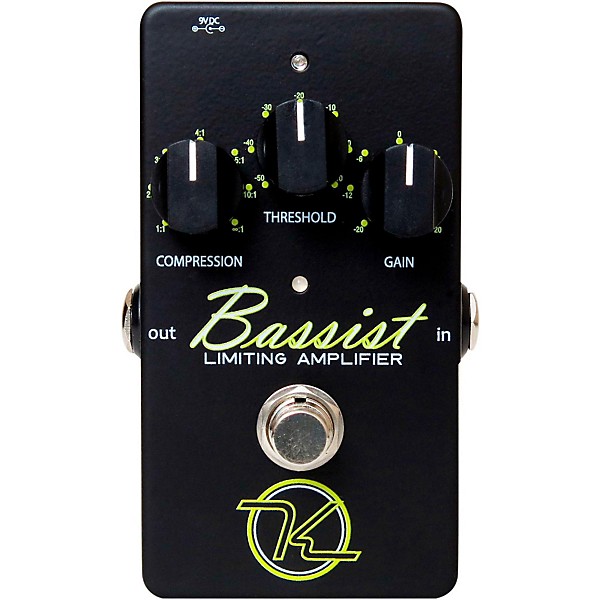TubeDigitalBoards
Top-Seller
Keeley Bassist Limiting Amplifier Bass Compression Pedal
(10)|Q&A|Item #:1418053833132 POS #:111884094
6-month special financing^ + $9 back in Rewards** Limited time Learn More
Lease-To-Own Purchase OptionsLearn more
Protect your gearLearn more
Cover drops, spills or cracks with Pro Coverage
Need Help?
Videos (1)
View All
Keeley Electronics - Bass Guitar Effects w/ Aaron Boehler
Description
The Bassist Compressor is built around the exotic and extremely high fidelity THAT Corp. 4320. Think of it as a very affordable studio-grade dbx compressor in stomp box format. It uses high performance Voltage Controlled Amplifiers, on board true-RMS detector, and ultra high performance op-amps to bring you the very best quality. VCA compressors give you precise control. Therefore they are directly suited to bass guitars. The Keeley Bassist Compressor is both musical and very transparent. Where Keeley's older compressors were based on the CA3080 or the LM13700 and are perfect for single coil guitars, the new Keeley Bassist Compressor has no problems with active pre-amps and line level input signals! Not only can the Keeley Bassist handle astonishingly large signals, it has an incredible bandwidth of over 20 KHz and incredibly low noise. No detail in your bass guitar's tone will be lost. The Keeley Bassist will be a sound investment in your tone, you now have rack-mount quality at your feet.
Compression and Threshold
When bass players use the Keeley Bassist Compressor they will be greeted with a sound that is more easily amplified and heard. Using the effect as a limiting amplifier saves your speakers from clipping and distortion. Set the Threshold to look for peaks in your signal and limit distortion from your amplifier or damage to your speakers. Simply watch the Threshold Indicator light to see what type of playing you want to limit, it's that easy! Next set the Compression Ratio Control to determine how much squash you want when the signal is above Threshold. Set Compression all of the way down for no (1:1) compression and use the Gain control as a boost! Set Compression all of the way up for an above-Threshold hard-knee limiter.
A typical soft compressor setting would be 2:1 above threshold. A good starting ratio for the Compression control may be 4:1 as it generally sounds good with bass guitar. A ratio of 5:1 or 6:1 will sound great for slap or funk-style playing. For synth-bass try 10:1 Compression.
Attack and Release
There is a certain figure that just sounds good as far as compression goes; and that's 125 dB/second. With feed forward compressors that use this type of true-RMS detector you use a single time constant parameter. The timing capacitor gives you attack and release times that are adaptive to your playing level or the signal input to the compressor. Bottom line: Attack and Release times vary on program content. Attack times are generally speaking, about 100 times faster than release times.
Compression and Threshold
When bass players use the Keeley Bassist Compressor they will be greeted with a sound that is more easily amplified and heard. Using the effect as a limiting amplifier saves your speakers from clipping and distortion. Set the Threshold to look for peaks in your signal and limit distortion from your amplifier or damage to your speakers. Simply watch the Threshold Indicator light to see what type of playing you want to limit, it's that easy! Next set the Compression Ratio Control to determine how much squash you want when the signal is above Threshold. Set Compression all of the way down for no (1:1) compression and use the Gain control as a boost! Set Compression all of the way up for an above-Threshold hard-knee limiter.
A typical soft compressor setting would be 2:1 above threshold. A good starting ratio for the Compression control may be 4:1 as it generally sounds good with bass guitar. A ratio of 5:1 or 6:1 will sound great for slap or funk-style playing. For synth-bass try 10:1 Compression.
Attack and Release
There is a certain figure that just sounds good as far as compression goes; and that's 125 dB/second. With feed forward compressors that use this type of true-RMS detector you use a single time constant parameter. The timing capacitor gives you attack and release times that are adaptive to your playing level or the signal input to the compressor. Bottom line: Attack and Release times vary on program content. Attack times are generally speaking, about 100 times faster than release times.
Features
- Studio-grade compression in a pedal
- User-friendly controls so you can find your perfect sound
- Attack Time: typically 15ms for 10dB, 5ms for 20dB, 3ms for 30dB
- Release Time: typically 8ms for 1dB, 40ms for 5dB, 80ms for 10dB, 160ms for 20dB, 240ms for 30dB




